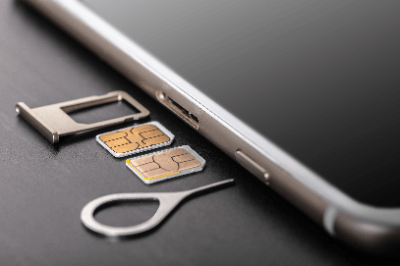What Is a SIM?

SIM, an acronym for “subscriber identity module,” is a small chip that stores a user’s contact information and phone number. It is essential for connecting a cellular phone to a carrier’s network.
SIM cards have evolved, with recent versions becoming smaller and more electronic, such as nanoSIM and eSIM.
Uses of SIMs
1. Smartphones
Smartphones can use SIMs for voice calls and data communication; SIMs allow users to choose their own phone numbers and communication plans. When traveling abroad, you can also save on roaming fees by replacing your SIM with a local SIM.
2. Tablets
Tablets can be connected not only to Wi-Fi, but also to mobile networks using a SIM, which allows you to access the Internet, e-mail, and social networking services while on the go. If the tablet has voice-calling capabilities, the SIM can also be used to make phone calls.
3. Laptop Computer
Some laptops can also be connected to a mobile network with a SIM, allowing access to the Internet, online meetings, and remote work even when Wi-Fi is not available. If the laptop has voice capabilities, the SIM can also be used to make phone calls.
4. Surveillance Cameras
Surveillance cameras can transmit video and audio in real-time using a SIM, making it possible to install surveillance cameras even in locations without an Internet connection. The video and audio sent from the surveillance camera can be viewed on a smartphone or PC.
5. In-Vehicle Camera
An in-vehicle camera can transmit drive recorder video and location data using a SIM, which can be used as evidence in the event of an accident or other trouble, or to remotely check the status of a vehicle. The images and location information sent from the in-vehicle camera can also be viewed on a smartphone or PC.
6. Digital Signage
When a SIM card is inserted into the digital signage, it can be connected to a mobile network. This allows digital signage to display real-time information and change the display according to timing.
Principle of SIMs
A SIM card stores crucial information including:
- IMSI (International Mobile Subscriber Identity): Identifies the carrier, country, and user.
- ICCID (Integrated Circuit Card Identifier): The unique identification number of the SIM card.
- Authentication Key (Ki): A secret key used for encrypted communications with the network.
- SMS and Contact Information: Some SIM cards store messages and phonebook data.
During communication, a cell phone sends the IMSI number to the base station for user verification and plan authentication. Encrypted communication is then initiated using the authentication key (Ki).
Types of SIMs
SIM cards are available in various types, each with specific features and suitability for different devices:
1. Mini-SIM
Common in older iPhone models and Android smartphones, the Mini SIM is larger, offering flexibility in handset changes but limiting handset design due to its size.
2. Micro SIM
Smaller than the Mini-SIM, the Micro SIM is used in newer iPhone models and tablets. It allows for a more flexible device design but requires an adapter for compatibility with Mini SIM devices.
3. Nano-SIM
The smallest type, Nano-SIM, is used in the latest smartphones. It offers maximum design flexibility but lacks compatibility with Micro and Mini SIMs without an adapter.